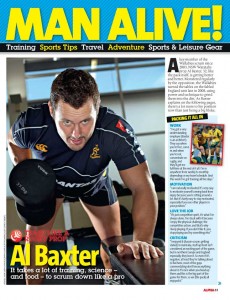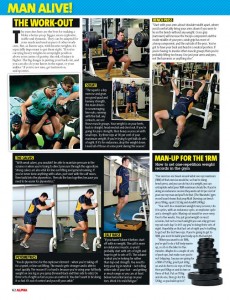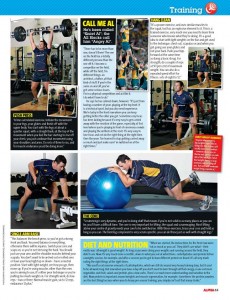 Train Like a Rugby Prop
Train Like a Rugby Prop
The curse of Ivan strikes again. Angry Al Baxter (big man, good bloke) helped me understand how he trains, but after I’d talked to him for Alpha magazine in 2009, he never played for the Wallabies again. I think Stirling Mortlock suffered the same fate, and he was captain. Photographer here was Sam Ruttyn.
________
A key member of the Wallabies scrum since 2003, NSW Waratahs prop Al Baxter, 33, like the pack itself, is getting better and better. Monstered regularly by other scrums, late last year the Wallabies turned the tables on the fabled England unit, using power and technique to grind them into the dirt. As Baxter explains on the following pages, there’s a lot more to his position now than just being a big bloke.
Work
I’ve got a very understanding employer (Baxter is an architect). They say when you’re free, come in and when you’re not, concentrate on rugby, and they’ll get me full-time at the end of it all. I’m in anywhere from weekly to monthly depending on what our travel schedule is. And this week I’ve got training all five days…”
Motivation
I am naturally motivated. It’s very easy to motivate yourself coming back from injury because you’re sitting around a lot. But it’s fairly easy to stay motivated, especially if you see other players in your position.
Love the job
It’s just competitive spirit, it’s what I’ve always done. I’ve stuck with it because I enjoy the physical challenge, the competitive action, and that’s why I keep playing. If you don’t like it, you stop playing and try something else.
Criticism
I enjoyed it (Aussie scrums getting slated). In Australia stuff up-front isn’t considered an exciting part of the game, but in Northern Europe and England especially, they love it. So even if it’s negative, at least they’re talking about it. But here, most of the guys commentating don’t know anything about it, it’s not talked about. It’s nice when you head up there and this is the big part of the game for them, so we (the pack) all enjoyed it.
 The Work-Out
The Work-Out
The exercises here are the best for making a bloke a better prop: bigger, more explosive, stable and dynamic. They can be adapted for your needs and used as part of other work-outs. But, as Baxter says, with heavier weights, it’s especially important to get them right. “If you’re carrying heavy weights in an upright position above your centre of gravity, the risk of injury is higher. The big danger is putting your back out, and you can also do your knees in the squat, your ankles.” If you’re not sure, get instruction, and spotters.
Squat
The squat is a key exercise and gives you good quad strength and hammy strength, the main drivers in scrummaging, line-outs running with the ball, any contacts, we use those muscle groups. Your weight is on your heels, back is straight, head neutral and chest out. If you’re going for pure strength, then heavy as you can with small reps. Try three reps at 90 per cent of your maximum weight. If you’re trying to get bulk do sets of eight. If endurance, drop the weight down. I need all of those at some point during the season.
Hang Clean
It’s a power exercise, and uses similar muscles to the squat, but has an explosive element to it. This is a trained exercise, very much one you need to learn from someone who knows what they’re doing. It’s a good idea to start with light weights on the bar and get used to the technique: chest out, scapulas on and when you get going use your glutes and not your back. Push your hips forward at the same time as doing a basic shrug. For strength, do a couple of reps at 90 per cent of maximum weight. You can also do a repeated speed effort for fitness: sets of eight-12.
Push Press
A line-out related exercise. Initiate the movement in your legs, your glutes and finish off with the upper body. You start with the legs at about a quarter squat, with straight back; at the top of the movement when you feel the bar starting to rise off your chest, you just continue that movement using your shoulders and arms. Do 3-6 sets, and for muscle endurance you’d be doing more.
The calves
With weak calves, you wouldn’t be able to maintain pressure in the scrums and when you’re trying to direct pressure through the opposition. Strong calves are also vital for lineout lifting general running. If you’ve never done anything with calves, just start with the calf raises, then build into the plyometrics. Then do the two together, because you need to be warm for plyometrics.
 Calf raise
Calf raise
If you haven’t done it before, start off with no weight. The calf is more an endurance muscle, so you’d probably start with sets of eight and hope to get to sets of 15. The volume is what you’re looking for rather than top-end strength.You need to keep your leg in neutral – not rolling either side of your foot and getting as much range as you can – at least below horizontal and up on your toes. Work it to mild fatigue.
Plyometrics
You do plyometrics for the explosive element – when you’re taking off for a sprint, lineout lifting and even an engagement in the scrum. The muscle gets stronger and able to react quickly. The reason it’s so hard is because you’re using your full body weight on one leg. Do
three sets of eight and as fast as you can control it. You don’t want to be doing it so fast it’s out of control and you roll your ankle.
Bench Press
Start with your arms about shoulder width, where you’d comfortably bring your arms down if you were to lie on the bench without any weight. Cross-grip (narrower) will increase the triceps component and the inside middle of your pecs; wide grip, has more of a bicep component, and the outside of the pecs. You’ve got to have your back and head in a neutral position. If you’re having to involve other muscle groups then you’re probably lifting too heavy. Use just your arms and pecs, not the hammies or anything else.
Single-arm raise
This balances the bench press, so you’ve got a strong front and back. You need balance in everything, otherwise there will be inuries. Switch your core and scaps on, so you’re not stressing the back. You should just use your arm and the shoulder muscles behind your scapula. You don’t want to be arched out or rolled over, or have your head right up or down – have a neutral position. Start with light weight, see how you go, then move up. If you’re using muscles other than the ones you’re aiming to use, it’s either poor technique or you’re putting too much weight on. For strength work, do low reps – two or three. Normal muscle gain, six-12 reps, endurance 12-plus.
The Core
Scrumming is very dynamic, and you’re doing stuff, which means if you’re not solid in as many places as you can be, you’ll have a difficult time. For me the core is very important for lifting, the squat and scrummaging. Most lifting above your centre of gravity need your core to be switched on. With these exercises, the bent-leg component is very scrum-specific: you can do these just as well with straight legs, which concentrates on pure core stability.
Man-up for the 1RM
How to set one-repetition weight records in the gym
Our exercises are based around what one rep (1RM) of that exercise would be, so if we’re doing bench press, and you can do four at a weight, you can extrapolate what your 1RM maximum should be. If you’re doing an endurance session they work out 60 per cent of your one-rep max and you’ll do that.
You can’t do a maximum weight every session, there’s no way for your body to recover. I do it in cycles, with an endurance cycle, an explosive cycle and a strength cycle. Maxing out would be once every four-five weeks. You put good weight on most sessions, but not so much weight you can only get one rep out each day. So let’s say you’re doing three sets of eight. Hopefully on that last set of eight you’re battling to get out the last two reps. If you’re going to get to 1RM.You need to build your body up to get to that weight.
On the day you want to do 1RM, you’ve got to do a full body warm-up, so sit on the bike for five minutes to get the blood flowing. Maybe do a couple of sets of push-ups, but make sure you do just the right amount so you’re not fatiguing. Say you are going for a 1RN of 120kg, you’d put 60kg on and do five-six reps of that, then put 80kg on and do two or three of that. Put on 110kg and do one, then go for the 120, so you build up to it.
Heavy Weight Warning!
Anyone who gets to use very big weights, especially on things like bench press, will usually have three spotters – someone above you on the bar and a person on each side of the bar. If you fail at that weight there’s no way someone can lift 180 kilos off you. But even with moderate weight bring a spotter in.
Injuries
I’ve not had too many, thankfully, touch wood. I had an ankle reconstruction while I was playing Colts, so I was young enough that it didn’t have any impact on my future career.
I’ve missed five weeks this season with a calf tear, and missed a couple of weeks because of disc issues in my back, but I’ve never had a whole season out. I still get very frustrated. I want to be playing in the team, and when I’m not it’s tough. It’s very easy to overtrain at that point. This season I was busting to get back and did whatever I could, but for the first couple of weeks I was meant to rest and doing nothing is the hardest part of any of it.
Diet and nutrition
When we started the instructions for the front row was “eat as much as you can”. They didn’t care what – their motto was “all weight is good weight”. As long as you were doing your weights and running around the field, they didn’t care.
Now it’s very much more scientific, down to what you eat at what times: carbohydrates and protein before a weights session, for example and after a session you’ve got to have different protein on board. It’s all very much eating the right things at the right times.
We used to eat massive amounts of carbohydrates, which we still do around very heavy training days, but it used to be all week long. But now when you have a day off you don’t need to burn through all that energy, so we eat more vegetables and fruit, salads and protein, plus a few carbs. There’s so much more understanding and variation in the diet. Now protein is important around weights and muscle regeneration, for example. Sometimes the protein powders are the best thing because when you do heavy pre-season training, you don’t simply can’t eat that many steaks.
Chewing The Fat
Coaches are aware the forwards have more muscle bulk than the others: for guys who have to hold weight and need high levels of strength, they’re more concerned about pure muscle mass as opposed to whether you’re as skinny as a back. If you’re going to hold lots of weight, it’s impossible to stay as lean as some of the outside backs.
We do have skin-fold tests, but also an all-over body scan, called a dexa scan, where you lie on a table and the scan tells you what percentage of you is muscle, what percentage is fat… There is no hiding place.
Call Me Al
He’s been called “Quiet Al”; the All Blacks call him “Angry Al”. Will the real Mr Baxter please stand up?
“There has to be more than one, doesn’t there? The one on the field has a totally different persona than one off it. I become a competitor on the field, while off the field, I’m different things, an architect, a father, all that kinds of stuff. If you’re the same on and off, you’ve got some serious issues, I think. I’m in a physical competition and act like it. I do what I have to do.”
He says he has calmed down, however. “It’s just from having a number of years playing at the top level. It is a technical sport but you also just need experience. We’re lucky in the front row where you can keep getting better the older you get. “Sometimes my focus has been lacking because it’s very easy to get carried away with the emotion of the game, especially at Test level where you’re playing in front of enormous crowds and playing the anthem at the start. It’s very easy to lose focus and not do the right thing at the right time. Over the years I’ve learned to stop getting carried away so much and just make sure I’m switched on at the right times.”
________
See this as PDFs: